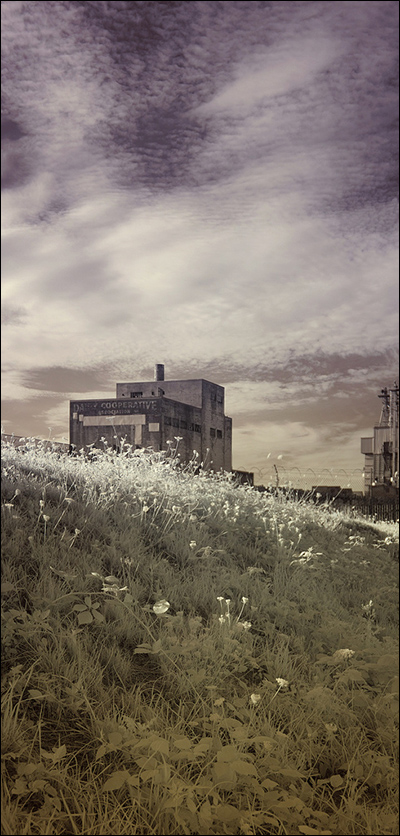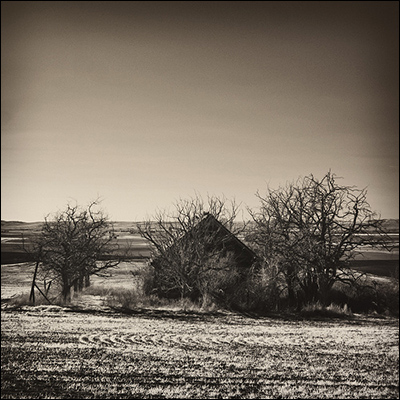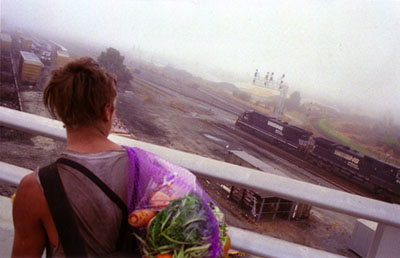We’re reviving Coilhouse Style Vanguard, a column that spotlights stylish individuals from around the world. Previously, we featured Princest – you can read her segment here.
I met Ryan Oakley in Toronto lat year. It was during my exhibit at the Plastik Wrap boutique – Ryan had just purchased one of my prints and I was oohing and ahhing over his immaculate outfit. It was composed of a suit tailored so precisely it would stop fashion non-believers in their tracks and a shirt, tie, vest and socks all clearly chosen with expert care. He was a pinstriped vision, carefully treading the line between aristocrat and pimp.

Ryan Oakley with his print
The suit-as-hipster-gear has been around for a long time, but this guy looked like someone who truly understood and respected it. There was a certain je ne sais quoi… An air of “that’s right, bitches” about him that I found entirely justified. Last week Ryan put forth his suit expertise in an informative and hilarious post simply titled The Used Suit. In fact, Ryan writes about men’s fashion a great deal in his multi-faceted blog, The Grumpy Owl. From the About page:
Although Ryan Oakley began his career as a simple rake, he has since become Toronto’s most renowned flaneur and notorious dandy. A composer of psychogeographic fictions, he is also a server of food, a tender of bar and a washer of dishes. While performing all these functions with efficiency and elegance, he has also found the time to publicly criticize books, theatre and the beleaguered women in his life. Mr. Oakley reserves some of his misanthropic vitriol for his own blog, The Grumpy Owl.
He’s also part of The Worldwide Culture Gonzo Squad, where he shares the blog-o-stage with several esteemed colleagues, including Coilhouse friend Jerem Morrow and Stylish Gent‘s M1k3y. So if Ryan’s masterful dandyism and tailoring insights aren’t enough to convince you that he’s one cool cat, check out some of his other posts, like Dinner With C’thulhu. It’s an instructional post where mister Oakley tells us how to entertain a precarious great old guest. Many topics are covered, from appropriate leather furnishing [“C’thulhu finds this comfortable as it allows ample room for Its tentacles but you will also be able to easily wipe any goo”] to dinner [“Human hearts are dreadfully difficult to obtain in today’s economy and the police tend to frown upon eating even the low quality, though well marinated, meat that can be found in your local hobo population”].

Without further ado, Ryan and his fashion philosophy, in his own words.
Tell us about the history of your look, its evolution.
I’ve been wearing suits since I was a child and, except for an unfortunate period during school, never lost the habit. When I moved to Toronto I quickly discovered that everyone pays the wrong sort of attention to just another punk kid. Since I was trying to drink underage and get away with a host of other ills, a suit and tie served me quite well. These were simple black affairs, stolen from thrift shops, ran into the dirt, covered with blood, then replaced with another.
There’s a lovely mugshot of me wearing a grey pinstripe but, sadly, the police refused to give me a copy. The scum.
When I finally quit drinking and drugging, I discovered that I had money but no real outlet for what’s an obsessive monkey in my mind. I dedicated myself, in earnest, to the vice of vanity. Anything worth doing is worth overdoing and the money I may have put to some reasonable use is now going to my tailor.
What is your style philosophy?
Style is philosophy. And I’m a logician. I view clothing as being a system of syllogisms, paradoxes and axioms. Like music or math, it attempts to be a pure expression of platonic reality. Colours, patterns and textures must harmoniously combine to form an elegant truth.
Because this is my view, I pay no attention whatsoever to fashion. Nor do I dress to express my office, my personality or my surroundings. I wear a suit because I’m a western man and the suit is the single best item of clothing we have.
Aside from being a recognizable and well-governed medium, thus an interesting one to innovate in, it also appeals to and combines the fundamentals that every animal uses in its fur and feathers. That is, the handicap principle, aposematism, cryptis and mimicry.
A suit is not a vulgar symbol of wealth, a display of superiority or an expression of bourgeois respectability. It is a beautiful thing. When I put one on, I hope for it to look equally normal and equally weird one hundred years in the past and one hundred years in the future. That’s the meagre dimensions of the sartorial truth I aspire to.
Click below for the rest of the interview, a video and more photos, of course.














